
Kimono are so closely linked to our image of Japan, it’s often one of the first things that come to our mind when thinking about the country. Because the beautiful garment is so representative of the culture, numerous kimono rental services offer tourists from all over the world to experience this amazing part of tradition. While today, the kimono is often seen as a costume, it once was genuine clothing, worn on a daily base. The word kimono itself means “something to wear.”
If you start to dive deeper into the world of kimono, beyond the common images of geisha and so on, you’ll find it to be surprisingly rich and deep. The variety of patterns and their meaning, some serious, others humorous, is fascinating and mesmerizing. We visited the famous souvenir shop Oriental Bazaar in Omotesando to take a thorough look at their extensive kimono department, in search for the manifold charms of this traditional Japanese garment. From historic marvel to modern fashion highlight, you’ll be surprised at the versatility of kimono!
Kimono, Then and Now
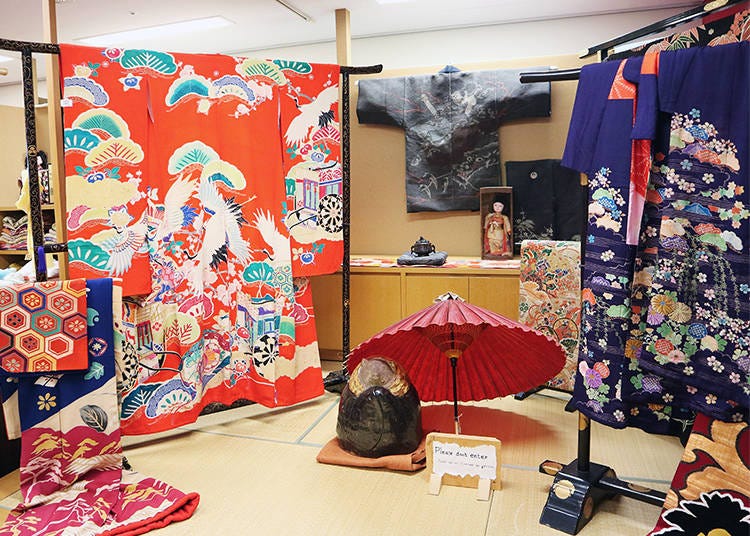
Around 70 years ago, the kimono still was worn daily all around Japan. Of course, it was common for both men and women to go out in Western clothes and change into a kimono once they returned home.
After the war, Western-style clothes made a major breakthrough and the kimono became a garment for special occasions, such as New Year’s Day or wedding ceremonies. This breakthrough wasn’t only caused by Western clothes being easier to move in, but also by women’s empowerment.
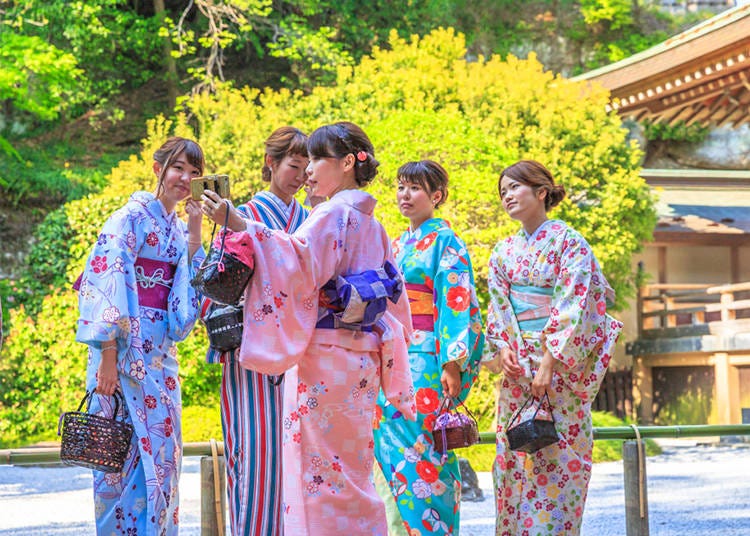
Today, it is decades ago that the kimono was worn regularly. Not only tourists find the garment difficult to put on—a lot of Japanese people share this sentiment. Despite its undoubted complexity, the kimono isn’t just worn for special occasions, but more and more international tourists and young Japanese rediscover the kimono as a fashionable garment, often combined with Western clothes.
Kimono, Komono, Obi – The Main Charm is Layers and Colors!
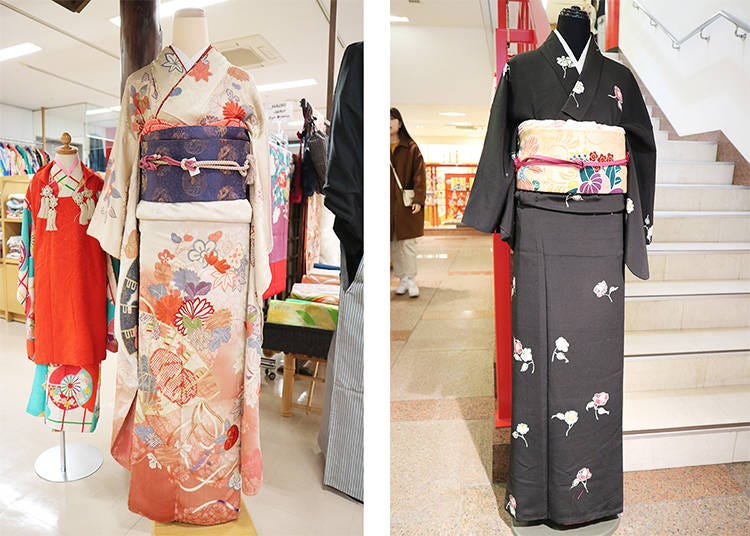
“The kimono has a culture of layers,” notes the staff. There’s the kimono itself, but also the belt holding it in place called obi, and a light garment worn under the kimono called nagajūban. They all overlap each other and what we call the “kimono” is only complete once everything is in place and there’s harmony between patterns and colors.
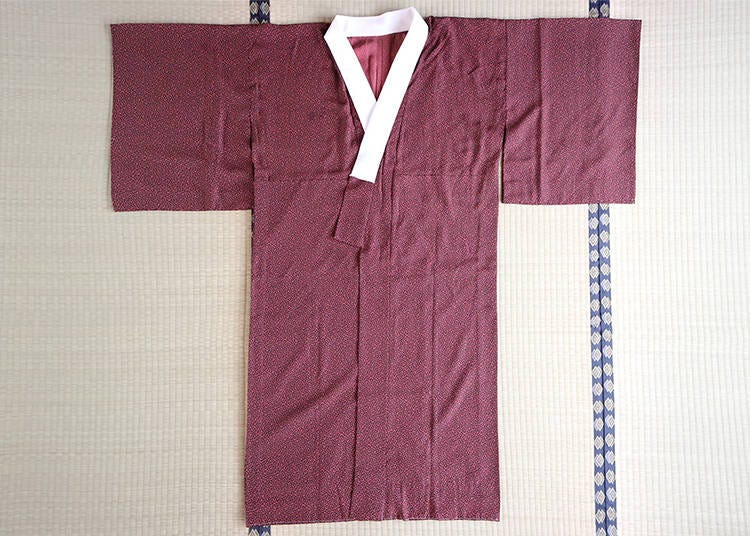
■ nagajūban: worn under the kimono. Once dressed, only the collar is still visible.

■ kimono: also called nagagi. The main part of the outfit.
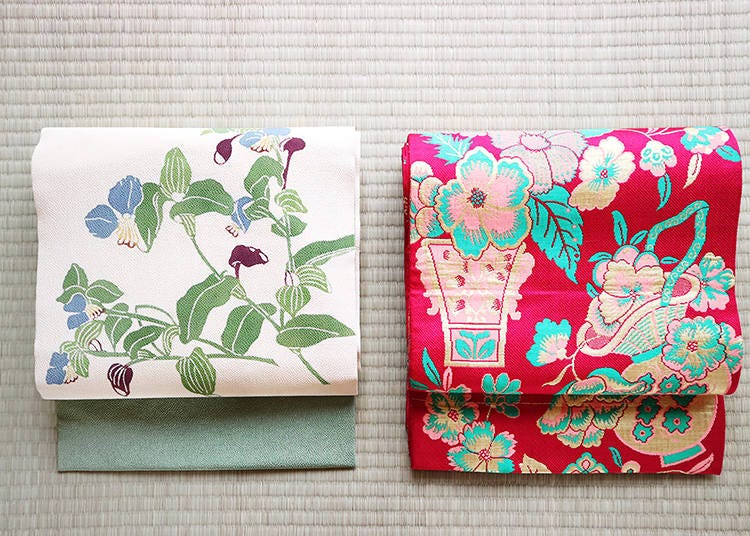
■ obi: a belt that holds everything in place. The outermost layer.
Originally, the kimono was held in place with only a string but in the late Edo period, it developed into the wide, decorative belt that we know today.

■ obijime: a decorative string over the obi, seen in the front of the picture. In the back is the obiage, a sash used to further decorate the belt. Technically, the obi is the outermost layer, but numerous smaller accessories called komono can be used to enhance the look.
Just looking at the various big and small accessories is an intriguing experience, as it illustrates the many different parts of a kimono outfit, as well as the skill and care every single one of them is made with.
There seem to be plenty of people who use things like the obijime as a belt for a pair of jeans, or the obiage as a small stole—creativity knows no bounds here.
Just like you’d wear different outfits to a party, going out with friends, or shopping by yourself, kimono also vary by occasion. If you look at the upper picture again, you’ll notice that the one on the left is much more gorgeous than the right one. It’s for formal occasions, just like you’d wear a suit or costume in the West. The kimono on the right is one that can be worn on a daily base, casual and uncomplicated.
The interesting thing about kimono is that they look entirely different depending on which occasion they are for, while the basic shape stays nonetheless the same. Style is determined by patterns, colors, and accessories.
Seasonally Chic: Kimono Patterns and Their Meanings
Kimono outfits are created by combining layers. Now, let’s look at popular seasonal styles and their combinations, as recommended by the staff. Let’s start with summer!
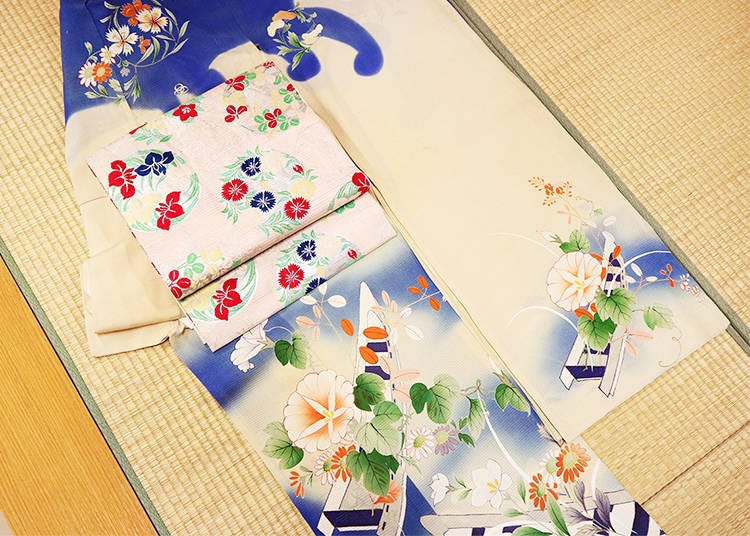
Summer: a chic pattern to keep you cool
in the picture is a summer kimono that uses is made out of silk gauze. This gauzy material is characteristic for a cool, refreshing feeling, both on the skin and for the onlooker. Now take a look at the pattern—Japanese culture is filled with seasonal references and kimono play an important role in conveying this aesthetic. The spotlight on this kimono takes the Morning Glory flower, called asagao in Japanese. The other flowers of the pattern at bush clovers, Chinese bellflowers, and fringed pink, all representative of the summer months. Celebrating the seasons with beautiful patterns and clothes is something that a lot of countries have in common.
In this outfit, the obi also features a pattern of fringed pink. Linking the kimono and the belt via a common pattern is a common, beautiful way to further give the outfit a strong seasonal reference.

Winter: elegant and dignified, like the season itself
It is rather obvious that this kimono is for winter. The fabric doesn’t seem light and airy in the slightest, with its color being of a deep and rich azure.
Winter kimonos are made with a lining. Especially in cold areas with heavy snowfall, such as Tohoku, cotton is thinly stretched between the outer layer and the lining, to offer extra protection against the cold.
The pattern is a beautiful combination of snow-covered pine trees (called yukimochi matsu when found like this on a kimono) and cranes. Cranes are a so-called auspicious motif and can often be found on kimono, regardless of the season, but they originally came to Japan as a migratory bird during winter. Combined with a gold obi, this outfit is as dignified, calm, and beautiful as winter itself.
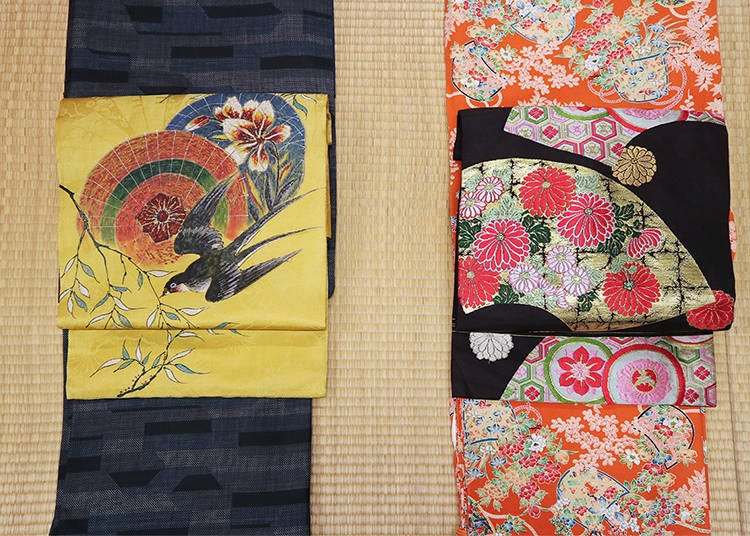
Spring: the swallow is a messenger of spring
The kimono on the left is an outfit designed for spring. The bright yellow of the obi symbolizes soft, warm sunlight. The swallow is a migratory bird and comes to Japan as a messenger of spring. This particular outfit can be worn from the end of winter, expressing anticipation for the next season while still matching with the last winter chill.
Autumn: rich colors, mirroring mountains and streets
The kimono on the right is a special recommendation for autumn. The warm orange of the kimono is combined with an obi featuring the chrysanthemum, autumn’s most iconic flower. The sky is the limit when it comes to putting together a beautiful kimono outfit!
Prayers, Skulls, and Bones? Japan’s Unique Kimono Motifs
However, the seasons aren’t the only thing used as an inspiration for a kimono pattern. As already mentioned, there are also auspicious motifs adorning kimono for all kinds of occasions, from weddings to everyday garments. In these designs, the creativity and philosophy of Japan and its people are wonderfully represented. Let’s take a look at some unique patterns.
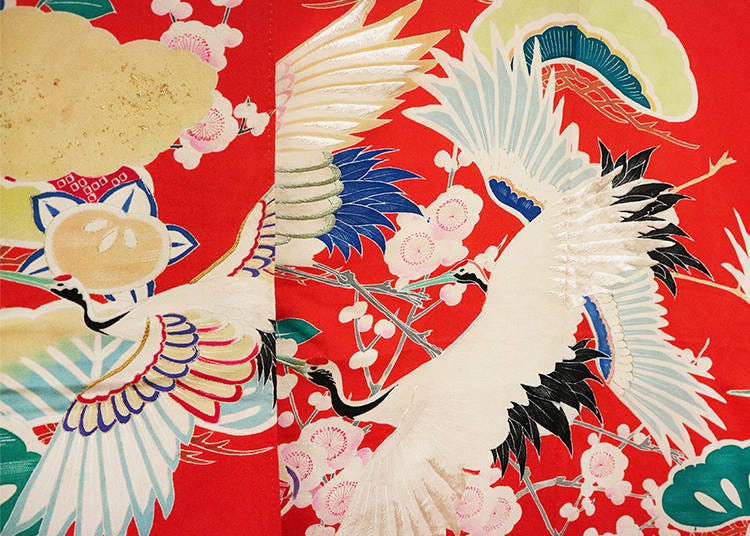
Good Omen: the Crane
The crane is often seen with a turtle, representing longevity. This pattern is considered to be a good omen. Furthermore, cranes are lucky birds for couples, so they’re often seen on kimono for wedding ceremonies. There, they express the desire to wish a couple love and happiness that lasts.
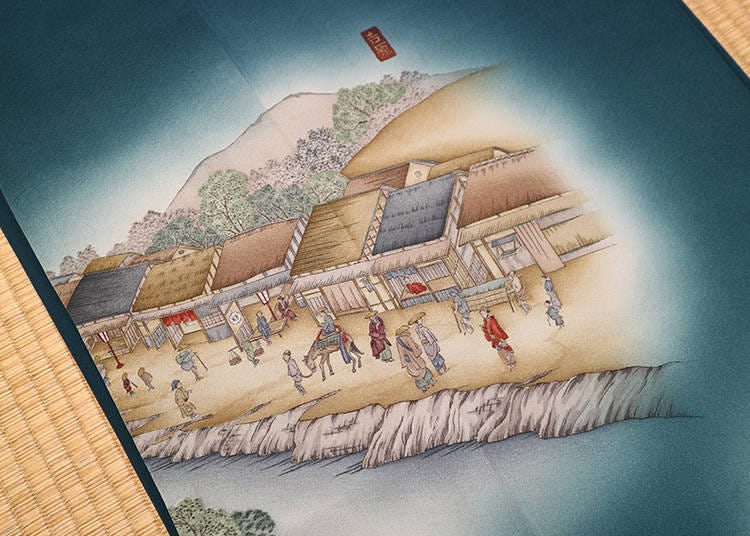
Sceneries: Cityscapes and Landscapes
International tourists especially like the designs that feature a city—or landscape. It is as if the daily buzz of days long gone comes alive on a beautiful garment.
Some patterns are centered on traditional forms of entertainment, featuring rakugo and kabuki scenes. Thus, they’re popular among fans of these old theater forms.
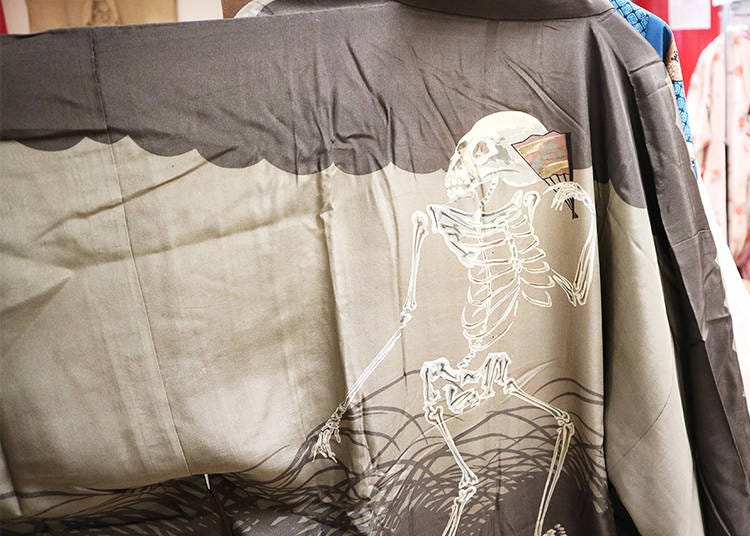
Protection Against Evil: Skulls and Skeletons
As weird as it may seem, skull and skeleton patterns can often be found on men’s nagajūban (“under-kimono”) or haori, a kimono-style jacket.
In the West, skulls and skeletons are often associated with evil. In Japan, however, they ward off evil and represent regeneration—you know, because they walk around even though they’re supposed to be dead.
In the picture above, we see a skeleton dancing with a folding fan and drinking alcohol. It’s definitely not sober anymore and meant to amuse the onlooker. Kimono patterns aren’t always serious and auspicious.
The Versatility of Kimono – So Many Things You Can Do With It!
A traditional kimono outfit is breathtakingly beautiful, there’s no doubt about that. However, the vivid colors and unique designs of a kimono can be used and enjoyed in all sorts of ways! Don’t let yourself be held back by old rules and let’s see what kind of modern, creative ways there are to make the most out of the traditional garment.
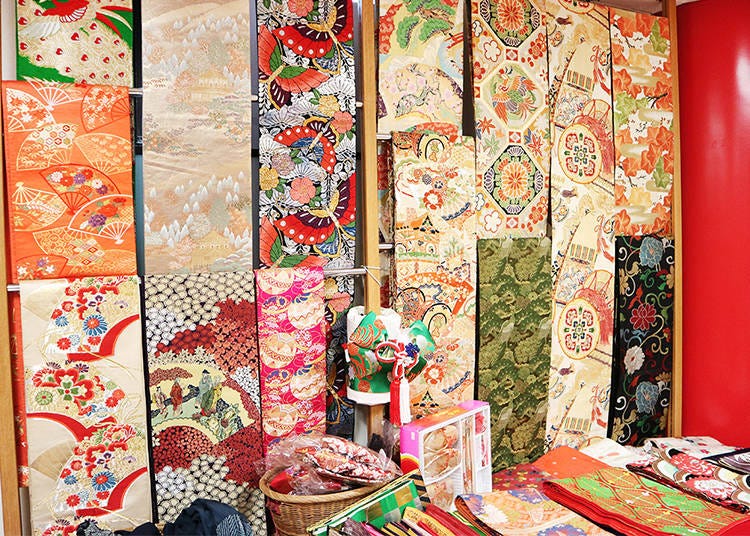
Idea #1: Interior Fabric
In a time when kimono and obi were still worn daily, the beautiful patterns weren’t only valued as a garment but also simply as a fabric. Especially the obi makes for a beautiful table runner or tapestry, due to its long rectangle shape.
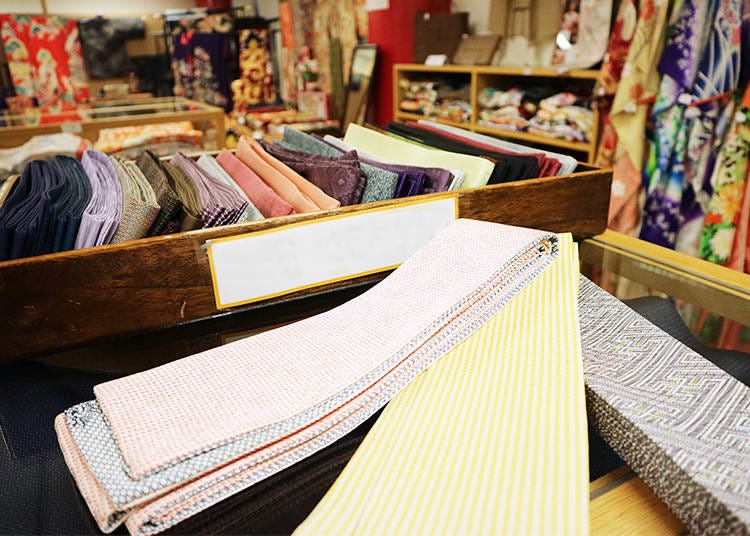
Idea #2: Turning an Obi Into a Regular Belt
This idea is an original of Oriental Bazaar, the shop that we are visiting for our kimono insights. They created an obi that is narrower and shorter than the traditional version. This allows you to wear antique kimono, which are shorter than modern ones, like a coat or jacket (or haori), simply using the shorter obi as a regular belt around your waist or hip.
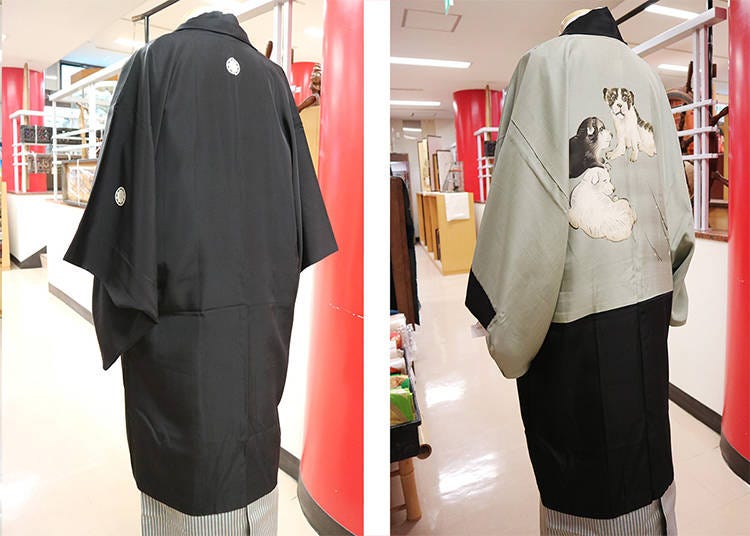
Idea #3: Fun Reversibles for Men
Men’s kimono usually are less colorful and have fewer patterns than women’s, they look much simpler. However, the patterns that they do have are bold and unique, a lot of them skillfully hide their design partially or totally inside the lining, making for amazing reversibles. The picture shows a haori jacket. On one side, it's elegant and black with a small family crest called a kamon. On the other side, there’s a picture of puppies, drawn in a traditional style and with delicate brushstrokes.
These garments may seem traditional, even old to some, but they’re nonetheless beautiful and it’d be a shame to not make the most out of them even nowadays. The bravest fashionistas are sure to find a way to integrate traditional kimono into a sublime avantgarde outfit!
Buying a Kimono
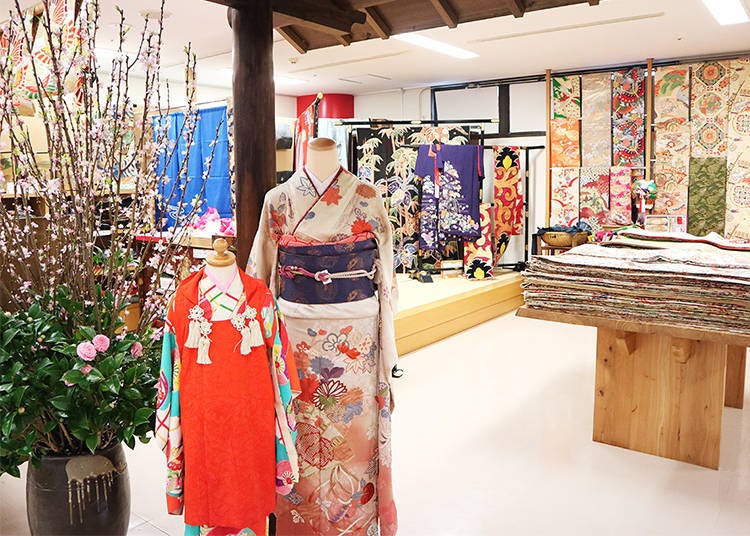
A kimono starts out as a roll of fabric that is about 37cm in width and about 13 meters in length. This is then tailored to a person’s measures. However, having a kimono tailor-made with an order takes time and is expensive, so it’s not necessarily the best thing for a souvenir. That’s why we recommend second-hand shops or antique shops that offer kimono. Exploring the selection feels a bit like treasure hunting!
Oriental Bazaar, the Shop We Visited
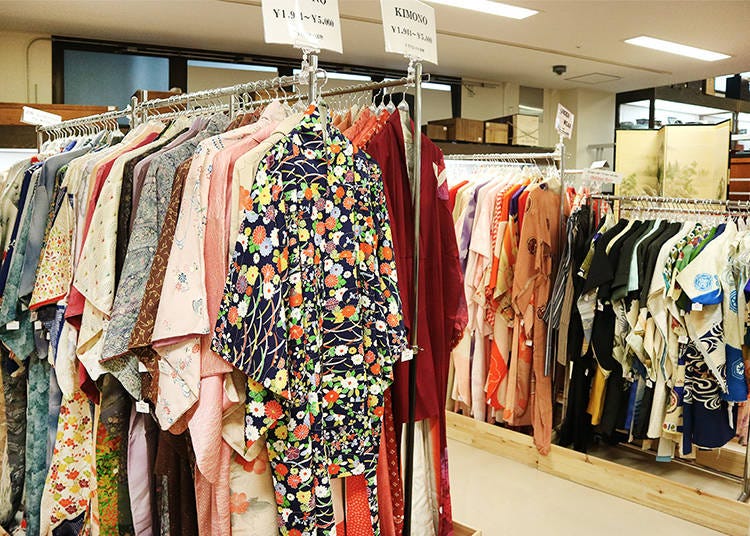
Oriental Bazaar is a 5-minute walk away from Harajuku Station and Meiji-jingumae Station. Here, you’ll find over 1,000 selection of second-hand kimono for about 2,000 to 3,000 yen, as well as antique kimono with amazing embroidery. Not only men and women get the chance to find a piece of Japanese tradition, but children’s garments are plentifully available as well. Find your best from 200 lineup of obi! The staff is able to speak English, so don’t hesitate to approach them with any questions you might have!
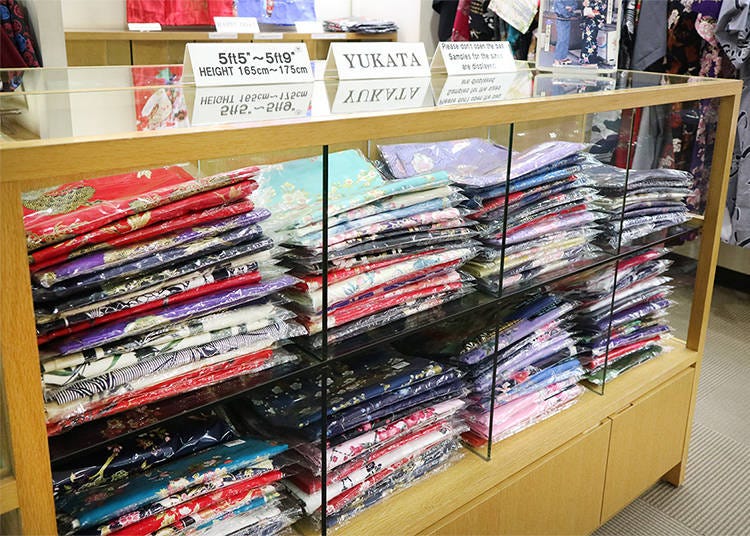
The basement floor also offers yukata, the light summer version of a kimono, throughout the year. Traditional types are also available but the modern, simpler versions are the easiest to actually put on.
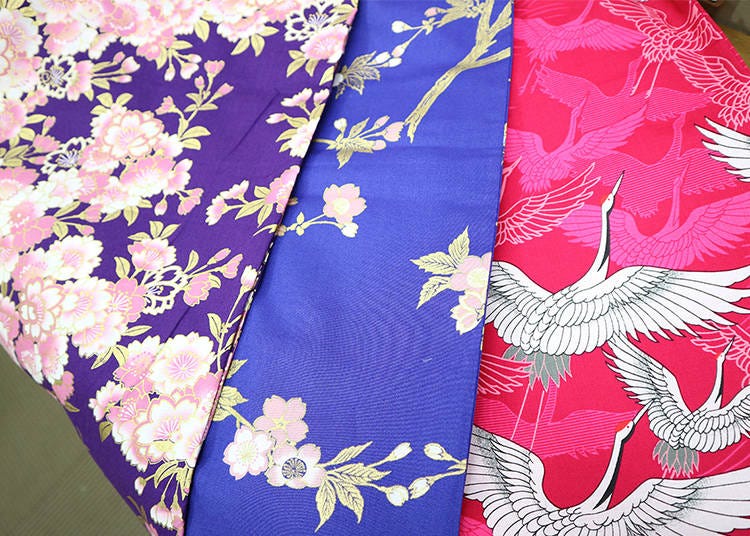
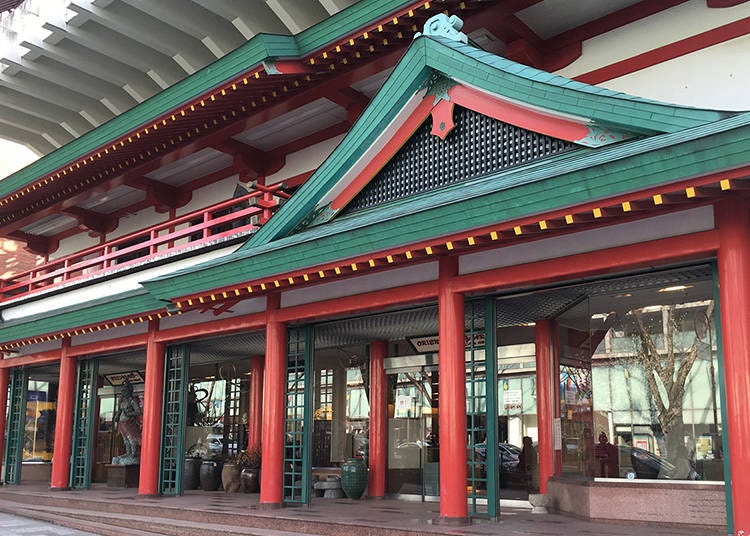
Browse the selection of traditional kimono, explore the vast world of patterns and designs, and maybe even find a uniquely Japanese accessory to fancy up your day-to-day fashion. Kimono is for everyone, so go ahead and find your own style!
-
 Oriental Bazaarオリエンタルバザー
Oriental Bazaarオリエンタルバザー-
Address
5-9-13 Jingumae, Shibuya-ku, Tokyo, 150-0001
-
Nearest Station
Meiji-Jingumae (Harajuku) Station (Tokyo Metro Chiyoda Line / Tokyo Metro Fukutoshin Line)
3 minutes on foot
- Phone Number 03-3400-3933
-
Address
5-9-13 Jingumae, Shibuya-ku, Tokyo, 150-0001
- Area
- Category
*Prices and options mentioned are subject to change.
*Unless stated otherwise, all prices include tax.
Popular Tours & Activitiess
Recommended places for you
-

Jujutsu Kaisen Takes Over JR East With a Wrapped Shinkansen This Winter
by: Guest Contributor
-

New in Ginza! Air BicCamera Ginza Opens with a Faster, More Convenient Shopping Experience
by: Guest Contributor
-

Strawberries, Style, and Tokyo’s Coolest Neighborhood: Winter Afternoon Tea in Kichijoji
by: Guest Contributor
-

How to Get Don Quijote's Exclusive 2025-2026 Winter Gift (+Tax-Free Savings)
-
Ad

Complete Guide to Ueno's National Museum of Nature and Science, the Perfect Place to Visit on Rainy Days or With Children
-

Japan’s Shinkansen Is About to Change Travel in an Unexpected Way
by: Guest Contributor
Inspiration for Accommodations
-

Enjoy Mt. Fuji from the Comfort of Your Room! Recommended Ryokan with Mt. Fuji View
-

Stay Near the Cherry Blossoms! Hotels for Cherry Blossom Viewing in Tokyo
-

Family-Friendly Hotels with Free Shuttle to Disneyland: Convenient Access for a Magical Stay
-

Top Ranked Hakone Hotels with Mt. Fuji View: Enjoy Stunning Scenery from Your Private Space
-

Convenient Tokyo Hotels with Airport Shuttle: Ideal for Families and Heavy Luggage
-

Stunning Tokyo Tower View Hotels: Enjoy Spectacular Scenery from Your Private Space
-

Convenient Asakusa Hotels with Kitchens: Ideal for Extended Family Visits
-

Experience Luxury: Hakone's 10 Best Five-Star Accommodations
-

Enjoy Mt. Fuji Autumn Leaves! Top Hotels Near the Popular Autumn Leaves Corridor
-

Experience Hakone Fall Foliage from Your Room with Stunning Views
-

This Awesome Tokyo Experience Will Make You Fall in Love with Japanese Music
by: David McElhinney
-

Complete Guide to Buying Japanese Medicine in Japan: Phrases and Vocabulary You Need to Know
-

Exploring Tokyo Station: 11 Must-Visit Spots Around the Heart of Tokyo
-

What is a Goshuin? All About Traditional Japanese Shrine Seals (and why you'll be addicted to collecting them!)
by: Lucio Maurizi
-

Ultimate Tokyo Transit Guide: JR, Subways, and Private Railways Explained, Plus Suica/PASMO and Money-Saving Passes
-

Seiyudo Katanas: Japanese Sword Heaven in the Heart of Tokyo (Video)
- #best ramen tokyo
- #what to buy in ameyoko
- #what to bring to japan
- #new years in tokyo
- #best izakaya shinjuku
- #things to do tokyo
- #japanese nail trends
- #what to do in odaiba
- #onsen tattoo friendly tokyo
- #daiso
- #best sushi ginza
- #japanese convenience store snacks
- #best yakiniku shibuya
- #japanese fashion culture
- #best japanese soft drinks



















